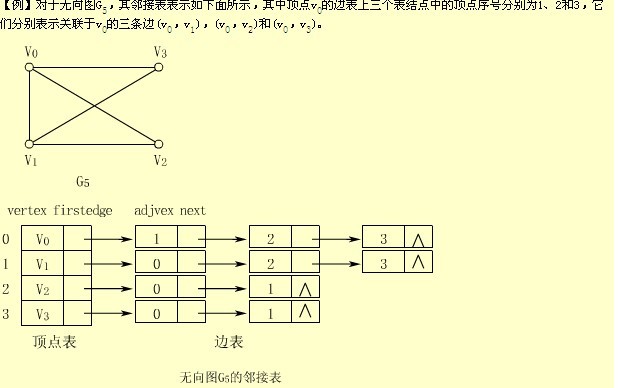图的邻接表存储 c实现 (转载)

用到的数据结构是
一个是顶点表,包括顶点和指向下一个邻接点的指针
一个是边表, 数据结构跟顶点不同,存储的是顶点的序号,和指向下一个的指针
刚开始的时候把顶点表初始化,指针指向null。然后边表插入进来,是插入到前一个,也就是直接插入到firstedge指向的下一个,而后面的后移
#define MaxVertexNum 100
typedef char VertexType;
typedef struct node //边表节点
{
int adjvex;
node* next;
}EdgeNode;
typedef struct //顶点表节点
{
VertexType vertex;
EdgeNode* firstedge;
}VertexNode;
typedef VertexNode AdjList[MaxVertexNum];
typedef struct
{
AdjList adjlist;
int n,e;
}ALGraph;
以下建立的是无向图的邻接表,有向图的更简单了
#include <stdio.h>
#include <stdlib.h>
#define MaxVertexNum 100
typedef char VertexType;
typedef struct node //边表节点
{
int adjvex;
node* next;
}EdgeNode;
typedef struct //顶点表节点
{
VertexType vertex;
EdgeNode* firstedge;
}VertexNode;
typedef VertexNode AdjList[MaxVertexNum];
typedef struct
{
AdjList adjlist;
int n,e;
}ALGraph;
void create(ALGraph*);
void main()
{
ALGraph* G= (ALGraph*)malloc(sizeof(ALGraph));
create(G);
for (int i=0;i< G->n;i++)
{
printf("%d->",i);
while(G->adjlist[i].firstedge!=NULL)
{
printf("%d->",G->adjlist[i].firstedge->adjvex);
G->adjlist[i].firstedge=G->adjlist[i].firstedge->next;
}
printf("
");
}
}
void create(ALGraph* G)
{
int i,j,k,w,v;
EdgeNode *s;
printf("读入顶点数和边数");
scanf("%d,%d",&G->n,&G->e);
for (i=0;i<G->n;i++)
{
fflush(stdin);
printf("建立顶点表");
G->adjlist[i].vertex=getchar();
G->adjlist[i].firstedge=NULL;
}
printf("建立边表
");
for (k=0;k<G->e;k++)
{
printf("读入(vi-vj)的顶点对序号");
scanf("%d,%d",&i,&j);
s=(EdgeNode*)malloc(sizeof(EdgeNode));
s->adjvex=j;
s->next=G->adjlist[i].firstedge; //插入表头
G->adjlist[i].firstedge=s;
s=(EdgeNode*)malloc(sizeof(EdgeNode));
s->adjvex=i;
s->next=G->adjlist[j].firstedge;
G->adjlist[j].firstedge=s;
}
}